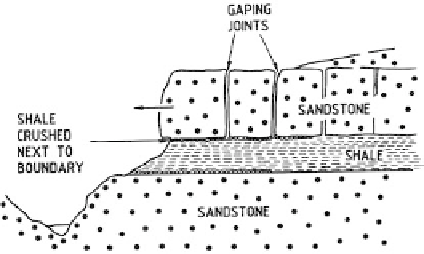Environmental Engineering Reference
In-Depth Information
while arkoses and greywackes usually produce clayey or silty sands. Siltstones usually
produce clayey silts or clays.
Some sandstones (usually weak, porous types) are locally strengthened in the weathered
zone, by the deposition of limonite in their pores.
It can be difficult in some sandstones (e.g. those with calcite or limonite cements) to dis-
tinguish effects of weathering from effects of processes involved in the formation of the
unweathered rocks. This can make it impossible to classify the rocks in the usual weath-
ered condition terms, e.g. those in Table 2.3.
3.6.4
Weathered profiles, and stability of slopes
Weathered profiles in the weaker, more porous rocks commonly show gradational bound-
aries between rock in various weathered conditions. This is also the case in the stronger,
more durable rocks when they are closely jointed.
Where large contrasts occur between the resistance to weathering of interbedded rocks,
sharp but irregular sawtooth shaped boundaries can occur as shown in Figure 2.23.
Figure 3.22 shows the type of mechanically weathered profile often developed close to
cliffs formed by near-horizontal sequences of thick sandstone beds underlain by or
interbedded with siltstones or shales. Crushed seams (bedding surface faults) occur along
the bed boundaries and steeply dipping joints have opened up in the sandstones. If these
effects only occur close to the side of the valley it is likely that they result mainly from
interbed movements due to stress relief - the shales/siltstones expanding further out of the
Figure 3.22.
Commonly observed features close to cliffs formed by horizontally bedded sandstones with
shale or siltstone interbeds. Based partly on Deere and Patton (1971).
Figure 3.23.
Collapse of outcropping sandstone beds due to removal of support of underlying shales
(Based on Figure 13b of Deere and Patton, 1971).



